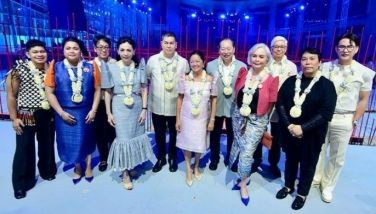The way to Carolina bamboo garden

How to go to Carolina bamboo garden is an oft-asked question these days. Already, an exodus to the place has been a-forming, now that people who are concerned about climate change and greening the environment are looking for the bamboo plant from which one can build churches and houses, weave fabrics (for shawls and clothes and table and bed linen and footwear), create musical instruments and fans and hats and toys and vases, rugs and carpets and mats, cook dishes (as atsara and with coconut milk) , and execute exquisite landscapes out of a host of varieties of the bamboo plant.
Check the Internet, and you read that bamboo is a group of perennial /wiki/Evergreen”evergreens in the true grass family Poaceae, subfamily Bambusoideae, tribe Bambuseae. You’re told too that bamboos are some of the fastest growing plants in the world, due to a unique rhizome-dependent system. They are of notable economic and cultural significance in South Asia, South East Asia and East Asia, being used for building materials, as a food source, and as a versatile raw product.
I was fortunate to be invited to join members of the Asian Development Bank Spouses Association touring the paradisiacal garden a couple of weeks ago. Got to the place in separate vehicles, via Marcos highway up to Sitio Tanza II, Barangay San Jose, Antipolo City. The garden owner, Carolina “Kay” Gozon Jimenez, was waiting to greet the dozen ladies to a five-hectare property, one-third of which has been transformed into a forest of bamboo plants and seedlings — from nasty, hardy cogon fields starting ten years ago.
We followed a path under arching bamboos on both sides, and the ladies, led by the association president, Koniko Kuroda, were awed by the sight of some of the 37 varieties, among them bayog, buho, Buddha belly, yellow buho, anos, bolo, hedge, yellow buho, kawayan tinik, Oldham, Thailand bamboo, Machiku and Wamin. The bayog, anos and and bolo are indigenous to the Philipppines, and the rest are from Indonesia, China, Columbia, Taiwan, South-East Asia and Japan.
These plants have different uses — as materials for food, making sawali, housing construction, fish traps, park landscaping and ornamentals, fences, windbreaks, furniture, and papermaking.
Kay Jimenez is a University of the Philippines business graduate, and worked with the Central Bank’s department of economic research for 11 years. She became a businesswoman exporting handicrafts for 12 years. When her mother, the late Tia Arling Gozon gifted her children with pieces of property, Kay put her share to good use, and in cooperation with the Ecosystems Research and Development Bureau (ERDB) of the Department of Environment and Natural Resources, started the garden as a project under Majent Foundation, of which Kay is director.
“Since I was a little girl, I’ve been fascinated by the bamboo plant,” says Kay. “I liked the swaying of the branches and the swishing sounds they made. I think today that Filipinos are so like the bamboo plant — so resilient, and so sturdy in spirit. So when the opportunity came for me to make use of a piece of land, I immediately thought of planting bamboo.”
Bamboo, she said, provides our three basic needs — for food (“We eat atsara”), clothing (“my old nightgown is made from bamboo”), and shelter (“Look at our unique bahay kubo, look at the many houses using bamboo.”) And she added, with twinkling eyes, “A guy came over to buy hundreds of seedlings of the tinik bamboo. I asked why he’s buying so many, and he said he will build a church from the bamboo seedlings he’s planting four years from now.”
Kay, a dynamic environmentalist, went beyond a bamboo-planting hobby, as she embarked on a grand seedling propagation program. Local government units and private real estate developers buy her seedlings to shore up river banks, and rolling hills to prevent soil erosion, and add greenery to landscapes. The most popular of seedlings sold is tinik, for prevention of soil erosion, and for perimeter fences. “You can plant tinik for your fence, and no intruder can ever enter your property because of the thorny bamboo they can’t penetrate.”
Kay feels gratified about her vision being realized, that of helping “create an ecologically balanced and clean environment by way of propagating and distribution of best quality exotic and indigenous bamboo seedlings, and to promote best environmental practices through research and development.”
“Planting bamboo,” she told the ADB ladies, “is a great way to reduce carbon footprint and help fight global warming. It’s a crucial element in the balance of oxygen and carbon dioxide in the atmosphere.”
Basic to bamboo-propagating is teaching would-be planters through seminars offered by Carolina Bamboo Garden. Participants are taught to plant bamboo on land and in water, using cuttings and other methods for planting.This year’s will be the eighth seminar, to be held Oct. 13, from 8 to 4:30 p.m. Kay says, “It’s called ‘Learn and Earn from Bamboo Experts,’” as lecturers are from UP Los Baños.
A source of pride for Kay is a unique three-tiered bamboo house designed by renowned 90-year-old architect Angel Lazaro Jr. The first and only one in the Philippines, it has a hyperbolic paraboloid roof design and a hanging staircase that can carry people with a combined weight of 400 lbs. To keep birds’ droppings from sticking to the roof and preventing the pawid from being blown off during storms, a mesh is wrapped around it.
Other tour stops were a butterfly garden, and a walk up 200 steps to the highest spot in the garden where one can view thick forests of bamboo and assorted fruit and ornamental trees, the shop displaying handicrafts made from bamboo leaves, roots, and split poles-masks and ostriches and four-legged animals, and a bike with bamboo features.
The tour with the ADB ladies wound up with a “native” lunch prepared by a former bank executive turned chef Gil Castro, in the rest house of Flor’s Garden, which is next door to Kay’s garden.
There was yet another treat — a floral arrangement session with Joyce Kato, a certified teacher from the OHARA School of Ikebana. Joyce conducts Ikebana lessons; now living in Ayala, Alabang, she stayed in Japan for many years and learned the art of Ikebana with a passion. At Flor’s Garden, she made adorable arrangements of flowers and leaves - and oh yes, bamboo leaves and poles. The ADB spouses had a thrill making their own compositions - with bamboo from Carolina, and flowers from Flor’s Garden and the flower market at Dangwa Bus Station.
For the October bamboo seminar and Joyce Kato’s workshops, one may call tells. (02) 816-3868 and (02) 816-387.
* * *
My e-mail:[email protected]
- Latest
- Trending




























